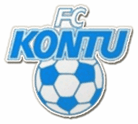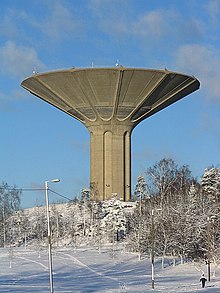
Helsinki is the capital and most populous city in Finland. It is on the shore of the Gulf of Finland and is the seat of southern Finland's Uusimaa region. About 682,000 people live in the municipality, with 1.26 million in the capital region and 1.6 million in the metropolitan area. As the most populous urban area in Finland, it is the country's most significant centre for politics, education, finance, culture, and research. Helsinki is 80 kilometres (50 mi) north of Tallinn, Estonia, 360 kilometres (220 mi) north of Riga, Latvia, 400 kilometres (250 mi) east of Stockholm, Sweden, and 300 kilometres (190 mi) west of Saint Petersburg, Russia. Helsinki has significant historical connections with these four cities.

Vuosaari is a neighbourhood in the City of Helsinki, Finland. It is located by the sea in East Helsinki and with its area of 15.38 km2 (5.94 sq mi) is geographically the largest district in the city. It also has two Helsinki Metro stations, Rastila and Vuosaari

Helsinki has a total area of 686 km2 (265 sq mi). 186 km2 (72 sq mi) of it is land and 500 km2 (190 sq mi) of the area is covered with water. It is located at 60°10′N24°56′E.

The Helsinki Metro is a rapid transit system serving the Helsinki capital region, Finland. It is the world's northernmost metro system. It was opened to the general public on 2 August 1982 after 27 years of planning. It is operated by Helsinki City Transport and Metropolitan Area Transport Ltd for Helsinki Regional Transport Authority and carries 92.6 million passengers per year.

Herttoniemi is an East Helsinki neighbourhood and a suburb of Helsinki, the Finnish capital.

Kontula is a quarter of Helsinki, Finland, part of the Mellunkylä neighbourhood. Kontula was built mostly in the 1960s and 1970s when more housing was required in Helsinki. Many people from the city centre moved to Kontula; due to its little higher than average concentration of government tenant housing complexes, immigrant and refugee population it is regarded as an average eastern Helsinki suburb.

Myllypuro metro station is a ground-level station on lines M2 and M2M of the Helsinki Metro. There are 97 bicycle and 40 car parking spaces at Myllypuro. The station serves the quarter of Myllypuro in East Helsinki.

Kontula metro station is a ground-level station on the M2 line of the Helsinki Metro. There are 273 bicycle and 53 car parking spaces at Kontula. The station serves the district of Kontula in East Helsinki.

Pasila is a part of Helsinki, Finland, that is both a central-northern neighbourhood and district, bordering the areas of Alppila to the south, the Central Park (Keskuspuisto) to the west, and Vallila to the east.

Itäkeskus is a quarter in the neighbourhood of Vartiokylä in Helsinki, Finland. The district's main attraction is the largest covered-in shopping mall in the Nordic countries, Itis, which make Itäkeskus as the most significant commercial center of East Helsinki. The district has a station on the Helsinki Metro, whose eastern entrance at the Tallinnanaukio square leads to the shopping centre. Itäkeskus has the eastern terminus of bus lines 500 and 550; the western terminus of line 500 is Munkkivuori and line 550 is Espoo's Westend bus station. Construction of the Jokeri light rail, which replaces bus line 550, began in 2019 and service began in 2023. The most important road connection to the Helsinki central from Itäkeskus runs along Itäväylä.
The city of Helsinki, the capital of Finland, can be divided into various sorts of subdivisions. Helsinki is divided into three major areas: Helsinki Downtown, North Helsinki and East Helsinki. The subdivisions include boroughs, districts, major districts and postal code areas. The plethora of different official ways to divide the city is a source of some confusion to the inhabitants, as different kinds of subdivisions often share similar or identical names.

Mellunkylä is a neighbourhood in East Helsinki, Finland. The area of Mellunkylä is 9,9 km2 and it has population of 36,360 (2005).

FC Kontu is a football club from Helsinki, Finland. It serves Kontula in East Helsinki and the immediately surrounding area. The club was formed in 1967 under the name Kontulan Urheilijat, the name being changed in 1994. The men's football first team currently plays in the Kolmonen and their home ground is at the Kontulan liikuntapuisto. The club also run a Ladies team that play at the same level in Women's Football.
The 2014 Finnish Cup(Suomen Cup) is the 60th season of the Finnish Cup. 152 clubs entered the competition, including all sides on the top two levels of the Finnish football pyramid, 29 sides from Kakkonen and 101 from lower levels. The winner of the cup enters the qualifying rounds of the 2015–16 UEFA Europa League.

FC Viikkarit are a Finnish association football team based in Vuosaari, East Helsinki. They play in the Kakkonen, the third tier of football in Finland, and are the reserve team of second-tier club FC Viikingit. The reserve team was established in 2007 and won promotion to the Kakkonen after the 2013 season. The team is managed by Alexei Zhukov, who had a long career as a player for the first team of the East Helsinki club.
The city of Helsinki and the neighbouring city of Vantaa have plans for a radical expansion of the Helsinki tram network within the 2020s and 2030s that would more than double the length of the network from 2021. If completed, the plans would both extend the current tram lines and build new light rail lines.

The Crown Bridges is the name given to three bridges under construction in the Finnish city of Helsinki, creating a new tram link and cycle path to the island of Laajasalo.

Maria Karoliina Ohisalo is a Finnish politician and researcher who served as Minister of the Interior between 2019 and 2021. The former chairman of the Green League, she has been a Member of Parliament since 2019.

Kalasatama is a neighbourhood in the city of Helsinki, Finland. The area is officially part of the Sörnäinen district; and like Sörnäinen, Kalasatama is located a little more than one kilometre north from the coastal centre of Helsinki, near the district of Hakaniemi, and the east side of Kalasatama borders the sea. Itäväylä, which leads in the direction of East Helsinki, runs next to Kalasatama. The Isoisänsilta pedestrian and cycling bridge, opened in 2016, connects Kalasatama to the nearby islands of Mustikkamaa, Korkeasaari and Kulosaari.

Sompasaari is an island on the Kruunuvuorenselkä water area in the Sörnäinen district in Helsinki, Finland. On the southern side of the Nihdinkanava channel built in the middle of Sompasaari is the island of Nihti.






















